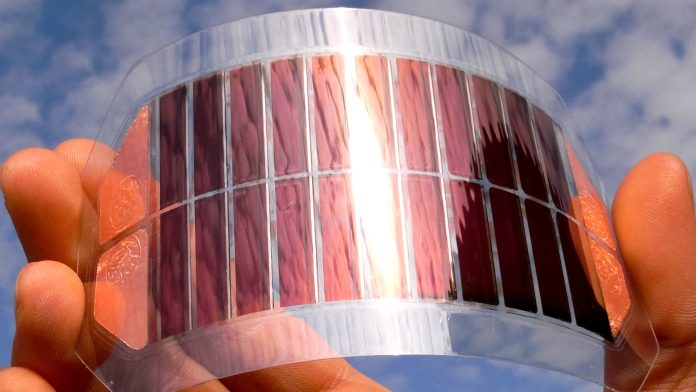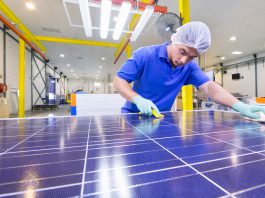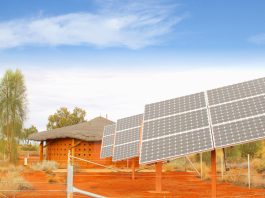Flexible solar cells have many potential applications in aerospace and flexible electronics, but low energy conversion efficiency has limited their practical use.
A new manufacturing method has increased the power efficiency of flexible solar cells made from perovskite, a class of compounds with a specific crystalline structure that facilitates the conversion of solar energy into electricity.
Current flexible perovskite solar cells (FPSCs) suffer from lower power conversion efficiency than rigid perovskite solar cells because of the soft and inhomogeneous characteristics of the flexible base material, made of polyethylene terephthalate (PET), the perovskite films of FPSCs are built upon.
FPSCs also have lower durability than rigid solar cells that use glass as a base substrate. Pores in flexible solar cell substrates allow water and oxygen to invade the perovskite materials, causing them to degrade.
To address these issues with current FPSC technology, a team of material scientists developed a new fabrication technique that increases the efficiency of FPSCs, paving the way for its use on a much larger scale.
How did the team increase the power efficiency of flexible solar cells?
Chenyi Yi, associate professor in the State Key Laboratory of Power System Operation and Control at Tsinghua University and senior author of the paper, explained: “Increasing the power conversion efficiency of FPSCs is crucial for several reasons.
“Higher efficiency makes FPSCs more competitive with other solar cell technologies, decreases the cost per watt of generated electricity and resources needed to produce the same amount of electrical power and increases the range of applications where FPSCs can be practically used.”
Specifically, the team developed a new chemical bath deposition (CBD) method of depositing tin oxide (SnO2) on a flexible substrate without requiring a strong acid, which many flexible substrates are sensitive to.
The new technique allowed the researchers more control over tin oxide growth on the flexible substrate. Tin oxide serves as an electron transport layer in flexible solar cells, which is critical for power conversion efficiency.
“This CBD method differs from previous research by using SnSO4 tin sulphate rather than SnCl2 tin chloride as a tin precursor for depositing SnO2, making the new method compatible with acid-sensitive flexible substrates,” said Yi.
Addressing durability concerns
Importantly, the new fabrication method also addresses some of the durability concerns over FPSCs.
Yi said: “The residual SO42-sulphate left over after the SnSO4-based CBD additionally benefits the stability of the PSCs because of the strong coordination between Pb2+ lead from perovskite and SO42- from SnO2.
“As a result, we can fabricate higher quality SnO2 to achieve more efficient and stable flexible solar cells.”
The team achieved a new benchmark for highest power conversion efficiency for FPSCs at 25.09% and was certified at 24.90%.
The durability of the SnSO4-based flexible solar cells was also demonstrated by cells maintaining 90% of their power conversion efficiency after the cells were bent 10,000 times. SnSO4-based flexible solar cells also showed improved high-temperature stability compared to SnCl2-based solar cells.
“The ultimate goal is to transition these high-efficiency FPSCs from laboratory scale to industrial production, enabling widespread commercial application of this technology in various fields, from wearable technology, portable electronics and aerospace power sources to large-scale renewable energy solutions,” Yi concluded.









